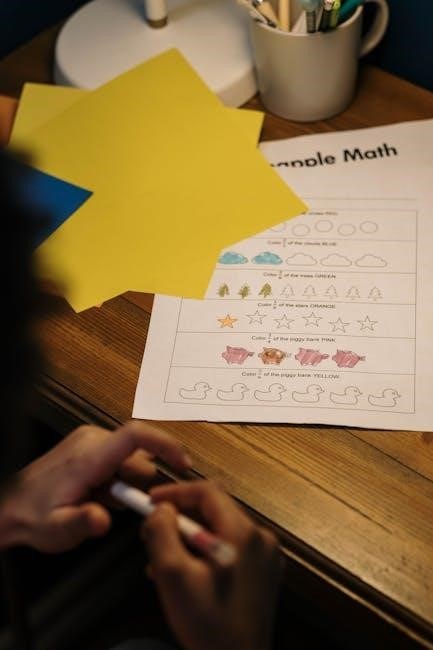Comparing fractions with unlike denominators is a foundational math skill that enhances critical thinking and problem-solving abilities. Worksheets like those from BYJUS FutureSchool and K5 Learnings offer structured practice‚ helping students grasp concepts through hands-on activities and real-world applications. These resources are ideal for grades 3 and 4‚ providing clear examples and benchmarks like 1/2 or 1 to simplify comparisons. Regular practice with such worksheets ensures a solid understanding of fraction relationships and prepares students for advanced math concepts. Explore free PDFs and interactive tools to make learning engaging and effective.
1.1 Understanding the Basics of Fractions
Fractions are a way to represent parts of a whole‚ with the numerator (top number) indicating the number of equal parts and the denominator (bottom number) showing the total number of parts. To compare fractions‚ especially those with unlike denominators‚ understanding equivalent fractions is crucial. Equivalent fractions have the same value but different forms‚ achieved by multiplying both the numerator and denominator by the same number. Worksheets‚ such as those from BYJUS FutureSchool and K5 Learnings‚ provide structured exercises to practice identifying and comparing fractions. These resources help students apply fraction concepts to real-world problems‚ ensuring a strong foundation for advanced math skills.
1.2 Importance of Comparing Fractions in Math Education
Comparing fractions is a vital skill in math education‚ as it builds a strong foundation for problem-solving and critical thinking. It helps students understand the relationship between different parts of a whole‚ enabling them to make informed decisions in real-world scenarios. Worksheets like those from BYJUS FutureSchool and K5 Learnings provide structured practice‚ ensuring students grasp fraction concepts thoroughly. Comparing fractions with unlike denominators enhances mathematical fluency and prepares students for advanced topics like ratios‚ proportions‚ and algebra. Regular practice with worksheets fosters confidence and accuracy‚ making it an essential part of early math education.

What Are Unlike Denominators?
Unlike denominators refer to fractions with different bottom numbers‚ such as 1/2 and 1/3. They require conversion to equivalent fractions for comparison‚ ensuring accurate mathematical analysis.
2.1 Definition and Examples of Unlike Denominators
Unlike denominators occur when fractions have different bottom numbers‚ like 1/2 and 1/3. To compare them‚ convert to equivalent fractions with a common denominator‚ such as 3/6 and 2/6‚ making comparison straightforward. This process ensures accurate analysis in mathematical operations. Visual aids and decimal conversions are also effective methods for understanding and comparing fractions with unlike denominators‚ enhancing comprehension and practical application in various mathematical scenarios.
2.2 Challenges in Comparing Fractions with Unlike Denominators
Comparing fractions with unlike denominators can be complex for learners‚ as it requires finding a common base for comparison. The primary challenge lies in identifying a common denominator or converting fractions to decimals. Students often struggle with understanding equivalent fractions‚ leading to incorrect comparisons. Additionally‚ simplifying fractions before comparison can be confusing‚ especially for those with larger numerators and denominators. Visual methods‚ such as fraction bars or number lines‚ can help overcome these difficulties. Encouraging practice with worksheets and real-world examples enhances proficiency and builds confidence in handling such comparisons effectively. Patience and repetition are key to mastering this foundational math skill.
Steps to Compare Fractions with Unlike Denominators
- Find a common denominator or convert fractions to decimals for easy comparison.
- Compare the numerators once the denominators are the same or use benchmarks like 1/2.
3.1 Finding Equivalent Fractions
Finding equivalent fractions is a crucial step in comparing fractions with unlike denominators. To do this‚ identify a common denominator by multiplying the two denominators together or finding the least common multiple (LCM). Once the denominators are the same‚ compare the numerators to determine which fraction is larger. For example‚ to compare 1/4 and 1/6‚ find equivalent fractions with a common denominator of 12: 1/4 becomes 3/12‚ and 1/6 becomes 2/12. This makes it clear that 3/12 (1/4) is greater than 2/12 (1/6).
- Multiply numerator and denominator by the same number to create equivalent fractions.
- Ensure both fractions have the same denominator before comparing.
- Use this method to simplify comparisons in worksheets.
3.2 Using Benchmarks (e.g.‚ 1/2 or 1) for Comparison
Using benchmarks like 1/2 or 1 simplifies comparing fractions with unlike denominators. By relating each fraction to these benchmarks‚ students can quickly determine their relative sizes. For example‚ if one fraction is greater than 1/2 and the other is less‚ the larger fraction is easily identified. Similarly‚ comparing fractions to 1 helps determine if they are less than or greater than a whole. This method reduces the need for complex calculations and enhances mental math skills. It is particularly useful for beginners to build intuition and confidence in fraction comparison. Worksheets often incorporate benchmarks to reinforce this practical strategy.
- Compare fractions to 1/2 to identify larger or smaller values.
- Use 1 as a benchmark for whole number comparisons.
- This method enhances quick decision-making in fraction problems.

Benefits of Using Worksheets for Practice
Worksheets provide structured practice‚ improving problem-solving skills and conceptual understanding. They offer repetition‚ reinforcing fraction comparison strategies and building confidence in math abilities for students.
4.1 Developing Critical Thinking and Problem-Solving Skills
Worksheets designed for comparing fractions with unlike denominators encourage critical thinking by requiring students to analyze and manipulate numerical relationships. They help students develop problem-solving strategies‚ such as finding common denominators or using benchmarks like 1/2 or 1. These activities enhance logical reasoning and mathematical fluency. Regular practice fosters independence in tackling complex fraction problems‚ building confidence in math abilities. By engaging with diverse exercises‚ students refine their analytical skills‚ preparing them for more advanced mathematical concepts in the future. This structured practice is essential for cultivating a deep understanding of fraction comparison and its practical applications.
4.2 Reinforcing Conceptual Understanding Through Repetition
Repetition in worksheets helps solidify the understanding of comparing fractions with unlike denominators by reinforcing key concepts repeatedly. Consistent practice ensures that students internalize the processes‚ such as finding common denominators or converting fractions to decimals. This repetition strengthens their ability to recognize patterns and relationships between different fractions. Over time‚ it builds a robust foundation‚ enabling students to apply these skills confidently in various mathematical scenarios. By revisiting the same principles in different contexts‚ students develop a deeper grasp of fraction comparison‚ making it easier to tackle more complex problems in the future. Regular practice also helps reduce errors and improves overall math proficiency.

Types of Worksheets Available
Various worksheets are available for comparing fractions with unlike denominators‚ including free printable options‚ worksheets with answers‚ and interactive formats for different learning needs.
5.1 Free Printable Worksheets for Grades 3 and 4
Free printable worksheets for comparing fractions with unlike denominators are widely available online‚ designed for grades 3 and 4. These worksheets are ideal for young learners‚ offering colorful visuals and engaging formats to make learning fun. They often include step-by-step instructions and examples to help students understand the concept of comparing fractions. Many resources are available in PDF format‚ making them easy to download and print. Popular websites like Teachers Pay Teachers and Math Worksheets Land provide a variety of options tailored to different skill levels. These worksheets are perfect for classroom use or homeschooling‚ ensuring students grasp the basics of fraction comparison effectively.
5.2 Worksheets with Answers for Self-Assessment
Worksheets with answers for self-assessment are invaluable tools for students learning to compare fractions with unlike denominators. These resources allow learners to verify their solutions instantly‚ fostering independent study and quick identification of errors. Parents and educators can use them to track progress and provide targeted support. Many educational websites offer such worksheets in PDF formats‚ making them easily accessible. By including correct answers‚ these sheets ensure accuracy and build student confidence. They’re particularly effective for grades 3 and 4‚ aligning with curriculum goals. Regular use enhances understanding and fluency in handling fraction comparisons‚ a crucial math skill for future concepts.

Where to Find High-Quality Worksheets
High-quality worksheets for comparing fractions with unlike denominators are available on educational websites like Khan Academy‚ Math Playground‚ and Teachers Pay Teachers. These platforms offer free PDF resources designed for effective learning.
6.1 Recommended Websites for Downloading Worksheets
Several websites offer high-quality worksheets for comparing fractions with unlike denominators; Math Worksheets Land provides free‚ customizable PDFs tailored to various skill levels. Worksheet Fun offers printable resources with clear instructions‚ while Super Teacher Worksheets includes answer keys for easy grading. These platforms ensure that students can practice fraction comparison effectively. Many websites also allow teachers to adjust difficulty levels‚ making them suitable for different grades. Additionally‚ some sites include visual aids like number lines or pie models to help students understand complex concepts. These resources are ideal for both classroom use and homework assignments‚ supporting a comprehensive learning experience.
6.2 K5 Learnings and BYJUS FutureSchool Resources
K5 Learnings and BYJUS FutureSchool are reputable platforms offering high-quality resources for comparing fractions with unlike denominators. K5 Learnings provides engaging‚ interactive worksheets designed to make complex concepts accessible. Their materials often include visual aids like fraction models and number lines‚ helping students grasp comparisons intuitively. BYJUS FutureSchool‚ known for its innovative approach‚ offers downloadable PDFs with step-by-step explanations and practice exercises. Both platforms cater to diverse learning needs‚ ensuring students can master fraction comparison at their own pace. These resources are ideal for teachers and parents seeking structured‚ curriculum-aligned materials to support math education effectively.

How to Use Worksheets Effectively
Start with clear goals‚ provide guidance‚ use real-world examples‚ and encourage self-assessment to maximize learning outcomes and retention effectively.
7.1 Tips for Parents and Teachers to Guide Students
To effectively guide students‚ parents and teachers should break down fraction comparison into manageable steps‚ using visual aids like diagrams or number lines. Encourage students to identify equivalent fractions and simplify comparisons by converting denominators. Provide real-world examples to relate fractions to everyday scenarios. Foster a supportive environment where questions are welcomed‚ and mistakes are viewed as learning opportunities. Regularly review progress‚ offering positive feedback to build confidence. Encourage self-assessment by checking answers and discussing common errors. Integrating interactive activities‚ like games or group work‚ can also enhance engagement and understanding. Consistent practice with worksheets helps reinforce these skills effectively.
7.2 Incorporating Worksheets into Daily Math Practice
Incorporating worksheets into daily math practice helps students develop consistency and mastery in comparing fractions with unlike denominators. Start with short‚ focused sessions to build confidence and gradually increase difficulty. Use worksheets that include visual aids‚ such as number lines or pie charts‚ to enhance understanding. Provide immediate feedback by reviewing answers together‚ highlighting correct methods and addressing errors. Encourage students to explain their reasoning‚ fostering deeper comprehension. Rotate between different worksheet types‚ such as those with real-world scenarios or puzzles‚ to keep practice engaging. Consistency and variety are key to making worksheets an effective tool for daily math practice.
Real-World Applications of Fraction Comparison
Fractions are essential in cooking‚ construction‚ and finance. Comparing fractions helps in measuring ingredients‚ understanding blueprints‚ and managing budgets effectively in daily life and professional settings.
8.1 Everyday Scenarios Involving Fraction Comparison
Fraction comparison is vital in daily activities like cooking‚ where recipes require adjusting ingredient ratios. For example‚ doubling a recipe might involve comparing fractions like 1/2 and 1/4 to ensure accuracy. In construction‚ contractors compare fractions to measure materials precisely‚ while shoppers use fraction comparison to evaluate pricing differences between products. Even in sports‚ understanding fractions helps in analyzing performance metrics. These real-world applications highlight the practical importance of mastering fraction comparison skills‚ making it an essential tool for problem-solving in various aspects of life.
8.2 Preparing Students for Advanced Math Concepts
Mastering fraction comparison with unlike denominators lays a strong foundation for advanced math. It prepares students for algebra‚ where fractions are used in equations and expressions. In geometry‚ comparing fractions helps in understanding ratios‚ proportions‚ and scaling. Additionally‚ it aids in grasping probability and statistics‚ where fractional data analysis is common. By developing critical thinking and problem-solving skills‚ students become confident in tackling complex concepts like decimals‚ percentages‚ and even calculus. This foundational skill ensures smooth progression and success in higher-level mathematics‚ making it indispensable for long-term academic growth.

Common Mistakes to Avoid
Students often mistakenly compare numerators or denominators directly without finding a common denominator‚ leading to incorrect conclusions. Misunderstanding equivalent fractions is another common error to avoid.
9.1 Misunderstanding Equivalent Fractions
One common mistake students make when comparing fractions with unlike denominators is misunderstanding equivalent fractions. Equivalent fractions are fractions that represent the same value but have different numerators and denominators. For example‚ 1/2 and 2/4 are equivalent‚ but students often fail to recognize this relationship. This misunderstanding can lead to incorrect comparisons‚ as they may not realize that equivalent fractions can simplify the process of comparing fractions. To avoid this‚ it’s essential to emphasize the concept of equivalent fractions and provide ample practice in identifying and creating them. Visual aids‚ such as fraction models or number lines‚ can also help students grasp this concept effectively.
9.2 Incorrectly Comparing Numerators and Denominators
A common error when comparing fractions with unlike denominators is incorrectly comparing only the numerators or only the denominators. For instance‚ students might assume that because the numerator of one fraction is larger‚ the entire fraction is larger‚ without considering the denominator. Similarly‚ they may focus solely on the denominator‚ thinking a larger denominator means a larger fraction. This oversight can lead to incorrect conclusions. To address this‚ students should be taught to compare fractions by converting them to equivalent fractions with common denominators or by using benchmarks like 1/2 or 1. This ensures a more accurate comparison of the fractions’ values.

Interactive Activities to Enhance Learning
Engage students with fraction comparison games‚ puzzles‚ and hands-on tasks. These activities make learning dynamic and fun‚ helping students grasp concepts more effectively while fostering collaboration and creativity.
10.1 Fraction Comparison Games and Puzzles
Fraction comparison games and puzzles are excellent tools for engaging students in interactive learning. Online platforms offer games where students can compare fractions with unlike denominators using visual aids like pie charts or number lines. Puzzles such as matching equivalent fractions or arranging fractions in order from least to greatest encourage critical thinking. Hands-on activities‚ like creating fraction bars or using real-world objects‚ make concepts tangible. These resources not only enhance problem-solving skills but also foster collaboration and fun‚ helping students build confidence in comparing fractions effectively. Incorporating games and puzzles into lessons ensures a dynamic and memorable learning experience for all students.
10.2 Group Work and Peer Teaching Strategies
Group work and peer teaching are powerful strategies to enhance learning when comparing fractions with unlike denominators. Group activities allow students to collaborate‚ share ideas‚ and learn from one another. Assigning roles‚ such as a leader or recorder‚ ensures active participation. Peer teaching encourages students to explain concepts to classmates‚ reinforcing their own understanding. Teachers can facilitate this by pairing students with varying skill levels‚ promoting mutual support. These strategies not only deepen comprehension but also foster teamwork and communication skills. By working together‚ students gain confidence in solving problems and applying fraction comparison skills to real-world challenges.

Assessing Student Understanding
Assessing student understanding involves evaluating their ability to compare fractions with unlike denominators through quizzes‚ tests‚ and observational checks. Teachers can use worksheets to track progress and identify areas needing review. Regular assessments help measure comprehension and retention of concepts‚ ensuring students are well-prepared for advanced math topics.
11.1 Using Quizzes and Tests to Evaluate Progress
Quizzes and tests are essential tools for evaluating students’ progress in comparing fractions with unlike denominators. These assessments help identify mastery of concepts and pinpoint areas needing improvement. Teachers can create short quizzes focusing on specific skills‚ such as identifying equivalent fractions or determining which fraction is larger. Tests provide a more comprehensive evaluation‚ covering multiple topics like fraction comparison‚ addition‚ and subtraction. Results from these assessments guide instruction‚ allowing teachers to adjust lesson plans and provide targeted support. Regular quizzes also build students’ confidence and familiarity with test formats‚ preparing them for larger evaluations. Consistent feedback ensures continuous improvement and understanding.
11.2 Tracking Improvement Through Worksheet Completion
Worksheets are valuable tools for tracking students’ improvement in comparing fractions with unlike denominators. By regularly completing worksheets‚ students build familiarity with the concept and develop problem-solving skills. Teachers can monitor progress by reviewing completed worksheets‚ noting accuracy and speed over time. The structured format allows for easy identification of areas where students may struggle‚ enabling targeted practice. Additionally‚ worksheets provide a sense of accomplishment as students see their improvement‚ motivating them to continue learning. Consistent use of worksheets ensures steady growth and prepares students for more complex math challenges‚ fostering confidence and a strong foundation in fraction comparison.

The Role of Technology in Learning
Technology enhances learning by providing interactive tools and digital resources for comparing fractions with unlike denominators. Apps and online platforms offer engaging exercises‚ making complex concepts more accessible and fun for students.
12.1 Digital Tools for Practicing Fraction Comparison
Digital tools provide interactive and visually engaging ways to practice comparing fractions with unlike denominators. Apps and websites offer step-by-step guides‚ interactive fraction bars‚ and customizable worksheets. These tools allow students to visualize fraction relationships and experiment with different values. Many platforms include games‚ quizzes‚ and real-time feedback‚ making learning more dynamic. For example‚ tools like Khan Academy and Math Playground offer free resources for fraction comparison. Digital tools also enable students to practice at their own pace‚ reinforcing concepts and improving problem-solving skills. They are especially useful for students who benefit from hands-on‚ interactive learning experiences.
12.2 Apps and Software for Interactive Learning
Apps and software designed for interactive learning offer engaging ways to practice comparing fractions with unlike denominators. Platforms like BYJU’S‚ Duolingo Math‚ and Splash Math provide interactive fraction comparison activities. These tools often include touch-and-drag fraction bars‚ virtual whiteboards‚ and customizable problem sets. Many apps adapt to the student’s pace‚ offering hints and explanations for incorrect answers. Games and rewards motivate students to complete exercises. For teachers‚ software like GeoGebra allows creating interactive lessons with visual models. These tools make learning fractions dynamic and accessible‚ providing immediate feedback and progress tracking to ensure mastery of comparing fractions with unlike denominators.
Mastering fraction comparison with unlike denominators is crucial for math proficiency. Worksheets‚ interactive tools‚ and persistent practice enhance problem-solving skills and foster a deeper understanding of fractions. Keep exploring!
13.1 Summary of Key Concepts
Comparing fractions with unlike denominators involves finding equivalent fractions or using benchmarks like 1/2 or 1. Key steps include identifying a common denominator‚ converting fractions‚ and then comparing numerators. Understanding equivalent fractions is vital‚ as they represent the same value despite different numerators and denominators. Real-world applications‚ such as cooking or construction‚ highlight the practical importance of this skill. Worksheets and interactive tools are effective for reinforcing these concepts. Regular practice helps build confidence and fluency in fraction comparison‚ ensuring a strong foundation for advanced math topics like ratios and proportions.
13.2 Encouraging Continued Practice and Exploration
Encouraging continued practice and exploration is essential for mastering fraction comparison. Parents and educators should foster a growth mindset‚ emphasizing that math is a skill refined over time. Providing access to diverse resources‚ such as worksheet PDFs and interactive tools‚ can keep learning engaging. Encourage students to explore real-world applications of fractions‚ like cooking or crafting‚ to see their relevance. Celebrate progress‚ no matter how small‚ to build confidence. By fostering curiosity and creativity‚ students will be motivated to delve deeper into math concepts‚ ensuring long-term understanding and enjoyment of learning.
